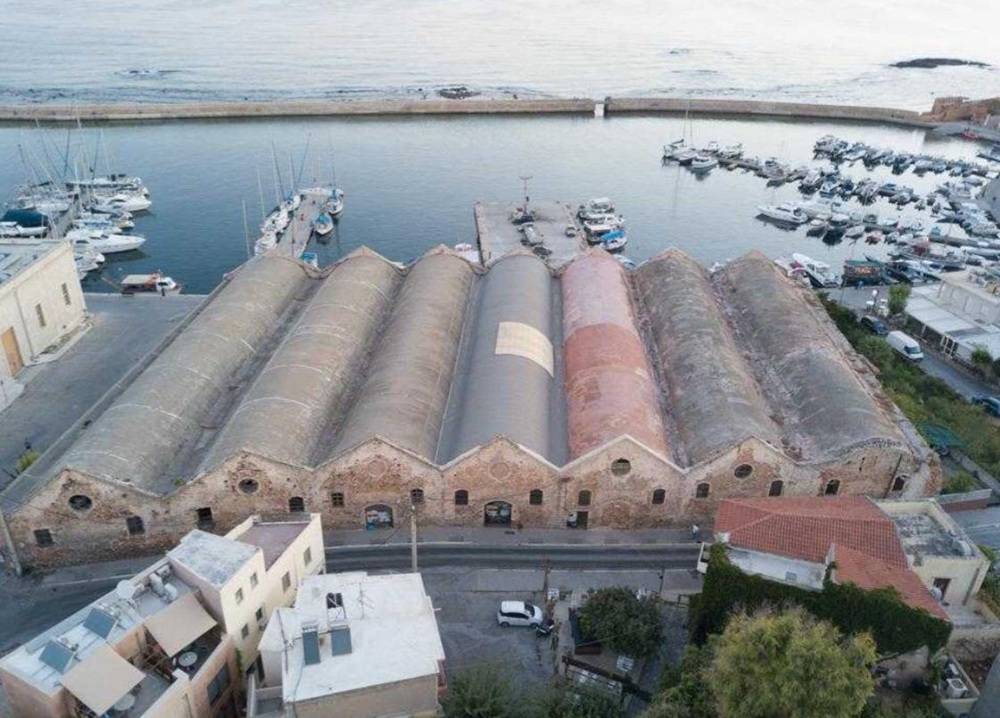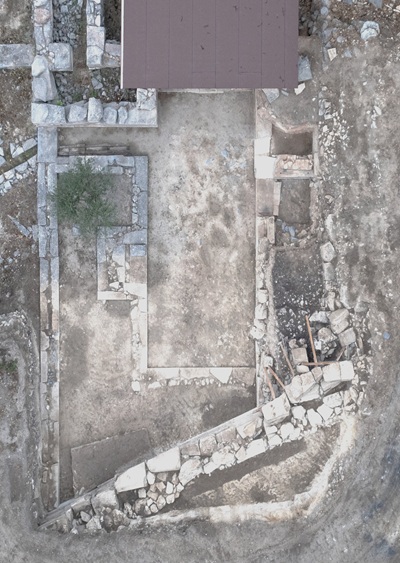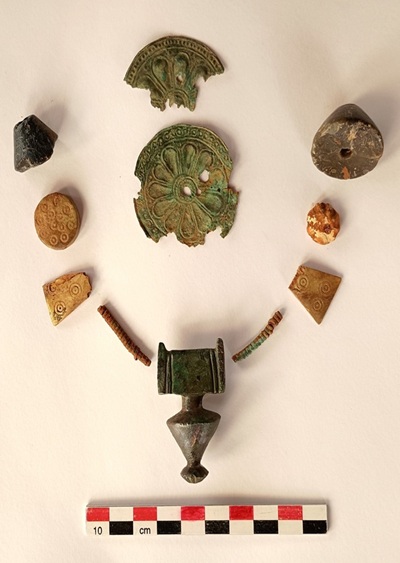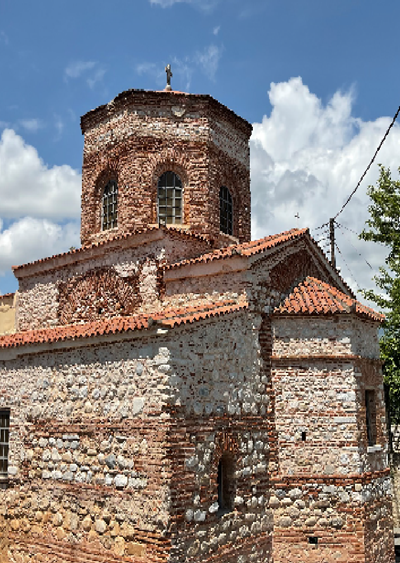
Culture Minister Lina Mendoni, as part of her working meetings and site inspections of ongoing or upcoming projects in Chania, in collaboration with the Region of Crete and the Municipality of Chania, has initiated an important cultural works program. She visited the Theodorakis House in Galatas and, following her cooperation with the Mayor and the responsible officials, announced the activation of the process to declare the Theodorakis House a protected monument, marking the start of a significant project for the preservation and promotion of the legacy of the great composer.
“Our visit to Chania today marks the beginning of important cultural projects as well as the planning of new ones, for which we have set the framework of actions. In Chania, we follow a comprehensive cultural strategy highlighting their unique cultural, architectural, and historical heritage through notable figures and emblematic monuments. The relevant services of the Ministry of Culture have started the process to declare the Theodorakis House a monument, something we owe to the memory of Mikis Theodorakis. The plan for the Theodorakis House includes its transformation into a museum space, with full respect for the creator’s wishes as expressed in his will. At the same time, in order to proceed with the restoration and reuse of Mikis Theodorakis’s family home in Galatas, the Ministry of Culture, with already secured funding of 350,000 euros from the Municipality of Chania through the “Antonis Tritsis” program, is doubling the budget to a total of 700,000 euros. Furthermore, the Municipality is arranging to purchase an adjacent property owned by the Bank of Chania to further enhance the functionality of the site. The Ministry of Culture will contribute 180,000 euros of the agreed total price of 200,000 euros, with the Municipality of Chania covering the remaining 20,000 euros. The goal is to create a cultural landmark that will strengthen the identity of the area, ensuring a lasting connection between the public and the life and work of Mikis Theodorakis.”

Research project by the Technical University of Crete, 900,000 euros, for the fortress of Icedin, the integration of the restoration works of the Venetian walls with the western moat.
The Minister of Culture, in Chania, signed the Cultural Development Programme Contract for the launch of the tendering and restoration process for the Venetian Nerites. This is a landmark project for the city, with a budget of EUR 22 million, which will enhance the cultural landscape and the image of the historic centre of Chania.
In a wide meeting held at the Town Hall, it was also decided to proceed with a draft double Programme Contract for Cultural Development for the preparation of studies for the restoration and reuse of the fortress of Itzedin, as well as the integration of ongoing restoration projects in parts of the Venetian fortifications with the western moat. The research and study programme, with a total budget of 900,000 euros, will be carried out by the Technical University of Crete, with financial support from the Ministry of Culture, the Region of Crete and the Municipality of Chania. The meeting was attended by the Head of the Directorate of Restoration of Monuments of the Ministry of Culture Themistocles Vlachoulis, the Curator of Antiquities of Chania Eleni Papadopoulou, elected officials, representatives of the Technical University of Crete, officials of the Ministry of Culture.
€22 Million for the Venetian Shipyards of Chania
The Neoria, an integral part of the Old Town of Chania, dominate the eastern side of the harbor. Of the seventeen shipyards built during Venetian rule, which served as a stronghold of the maritime power of the Most Serene Republic, today only the Great Arsenal on the western side and seven shipyards on the eastern side remain.
The restoration project was included in the DIATIRO-ESPA 2021-2027 program in April 2025 and is being implemented by the Municipality of Chania.
Following the signing of the programmatic agreement, Minister Lina Mendoni stated:
“The programmatic agreement concerns the restoration, enhancement, and repurposing of the complex of seven Venetian shipyards with a total budget of €22,000,000. With the cultural development agreement we signed with the Region of Crete and the Municipality of Chania for the Neoria, the now restored monument will be reconnected both with the sea, renewing its organic relationship, and with the dense urban environment of the modern city. Once the restoration is completed and their new uses are defined, the Neoria will be transformed into a major cultural hub and a developmental asset for Chania.”
The studies were carried out by the Technical University of Crete in collaboration with the Directorate of Monument Restoration of the Ministry of Culture and the Ephorate of Antiquities of Chania, with funding from the Region of Crete. The interventions include the stabilization and reinforcement of the buildings, the creation of two functional units: one for temporary exhibitions (Neoria 1–4) and one for events, lectures, and a café (Neoria 6–7), with the intermediate Neorio 5 serving as the entrance and space for a permanent exhibition.
Itzedin Fortress
The Cultural Development Programmatic Agreement plan for the Itzedin Fortress includes the research and study work for the restoration of the fortress and its reuse as a cultural space. Following the agreement, Culture Minister Lina Mendoni stated:
“For Itzedin, another very important architectural complex, charged also with modern history and which has been transferred to the Municipality of Chania, and in line with our commitments, we proposed and agreed on the solution of a programmatic agreement with joint funding from the Ministry of Culture, the Region of Crete, and the Municipality of Chania. Through this agreement, the necessary studies will be prepared to enable the implementation of the project. Similarly, with a second programmatic agreement, we will proceed with the unification of the southern section of the fortifications with the western moat and the entirety of the ongoing intervention. With all the ongoing and planned projects, we are showcasing in the best possible way the unique cultural identity of Chania.”
The Itzedin Fortress was designated a historic preserved monument in 1986, as it reflects the historical memory of the last 150 years, not only of the Souda area but primarily of Greek history. Construction began after 1871 and was completed in 1875. From the departure of the Turkish army until 1950, it was used as a prison, which continued to operate until the early 1970s when it was permanently closed.

Consolidation of the southern part of the fortifications and the western moat
The aim of the research project to be carried out by the Technical University of Crete is to highlight and unify the two sections (north and south) of the western moat with the southern moat, with a natural connection and a reminder to the rest of the southern section up to the eastern moat. The research project includes a survey of public space uses, the creation of a bridge on Meletios Pigas Street, proposals for uses, through soft interventions and highlighting the monumental character of the moats and the wall, showing their original function and significance, in relation to modern urban life, proximity to the sea and connection to public promenade areas.







Leave A Comment